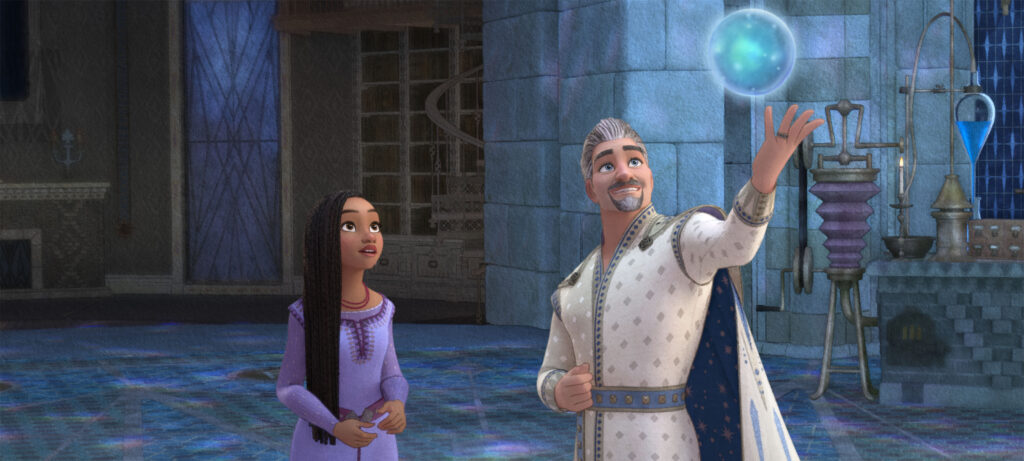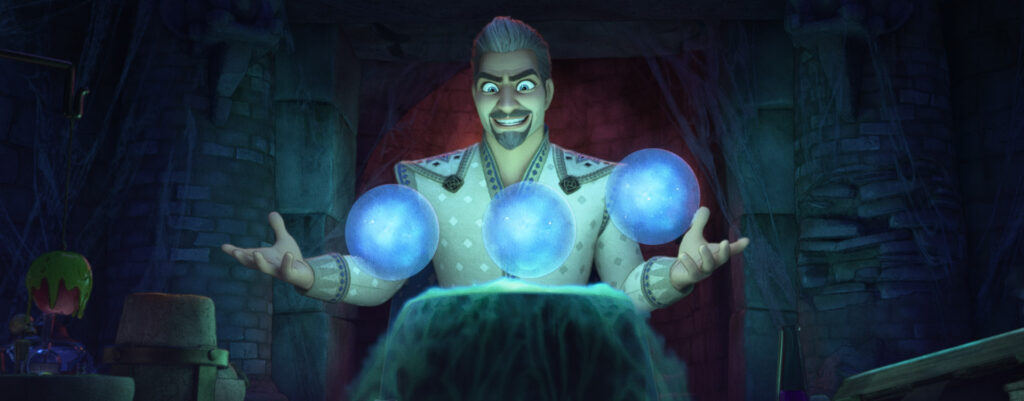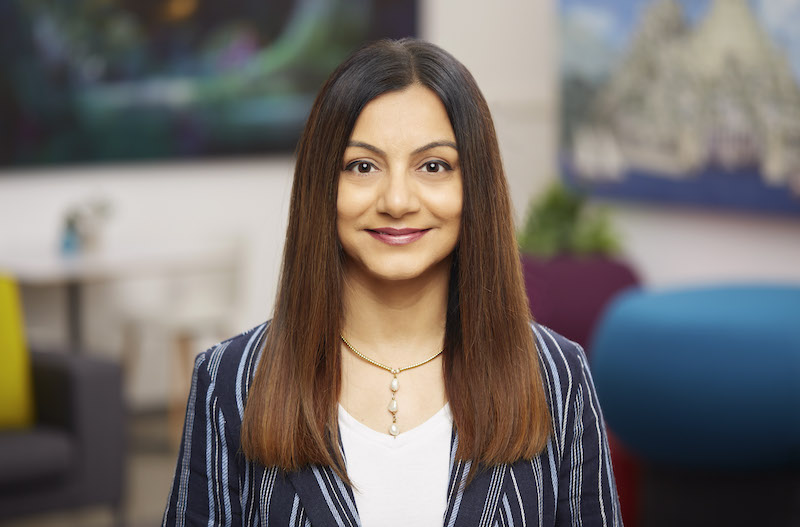
Known for its fairytale stories sprinkled with love, optimism, and bravery to fight against evil, celebrating its 100 years anniversary this year, the Walt Disney Animation Studios welcomed its audiences to Wish bringing back its watercolour style animation with hand-drawn influence. While critics may have faltered in their embrace, the film stands as a testament to Walt Disney Animation Studios’ unwavering dedication to visual mastery.
Set in the magical kingdom of Rosas, Asha, a sharp-witted idealist, makes a wish so powerful that it is answered by a cosmic force—a little ball of boundless energy called Star. Together, Asha and Star confront a most formidable foe—the ruler of Rosas, King Magnifico—to save her community and prove that when the will of one courageous human connects with the magic of the stars, wondrous things can happen.
Guiding the lifelike personas of these characters was the head of characters and technical animation of Wish, Avneet Kaur, a passionate advocate of the filmmaking process, fearlessly embracing the creative and technical challenges that each project presents. In an exclusive conversation with AnimationXpress, Kaur shared her experiences in shaping the film’s characters and pioneering its distinctive animation style.
As the head of characters and technical animation in Wish, what was the character brief, and how did you approach character development and animation?
As head of characters, I oversaw the creation of all character assets and the four departments responsible for crafting and authoring all CG characters, including the modeling, look development, rigging, and character simulation departments. As head of technical animation, I was responsible for art directing the character effects for all shots in the movie that went through technical animation, to realise the stylised vision of the directors and production designers.
Wish has a watercolour style with hand-drawn influences created by our incredibly talented CG artists at Disney Animation. As we met with the directors earlier on, our unifying vision was to craft a look of all characters that were inspired by the beautiful illustrative works of some of our earliest Disney Animation films including Snow White and the Seven Dwarfs and Pinocchio. (Gustaf Tenggren and Kay Nielsen are two of the many artists from our Disney legacy who inspired our look, as well as Eyvind Earle’s contributions to Sleeping Beauty.) The filmmakers wanted the inspirational artwork to transition to the film’s characters seamlessly and this was made possible by some cutting-edge artistry and technology, that was pioneered for our centenary film.
Could you tell us about the distinct stylisation on Wish? How was it created?
Realising a unique watercolour look for the characters, while they reflected the classic Disney appeal that also blended with and complemented the beauty of the backgrounds, was indeed an artistic challenge like no other for our studio. Earlier on in the pre-production process, the leadership, artists and technologists all came together and iterated for months to create the stylised look for our film. The new workflow that we developed to accomplish this art direction goal was developed by the lighting department, using the “Nuke” toolset. This procedural workflow was packaged into a set of modifiers so that the stylisation can be dialed by the character look development “lookdev” team, as needed on a per-asset basis. This was especially necessary so that the linework that was used on the characters could be carefully dialed and controlled based on the needs of the film.
The stylisation package wasn’t completely perfect out of the gate, so the lookdev team collaborated closely with lighting to come up with a system for handling different situations. Sometimes this was removing unwanted lines, adjusting aspects that looked too realistic, other times it was adding detail where we were lacking it. This pass of refinement had to be adjusted again when animation tests were explored, and the stylisation took an unexpected turn. Some of this stylisation is even adjusted for different distances from the camera and to account for how the character look was holding up against the backgrounds and environments.

Can you describe the collaborative process between different departments in bringing characters to life for Wish?
With the ambitious goal of having a unique watercolour stylised look in our film, our teams explored several initiatives and developed new workflows to guide the execution of our stylised characters. It was a huge multi-department collaborative effort between our character assets departments and technology as we partnered with our film’s cultural consultants, to make sure we created the right tools that enabled the creation of characters that are stylised, appealing and relatable by audiences around the world. To execute the stylisation workflow effectively for such a large scale of characters and in every shot of the film, we developed a slew of supporting tools for artists to quickly iterate and achieve the art direction goals.
Early on in our production, our technical directors and lighting teams developed an AutoComp tool that renders everything on our show in a stylised way by default. Throughout our asset production, our look development team worked closely with our lighting teams to develop a character stylisation diagnostic tool that allowed us to review the character at various distances to make sure it held up with stylisation at all sizes. Through the course of the two years of the film, we generated several lineup and calisthenics tests so we could consistently evaluate all the main characters in conjunction with each other in the same colour space and lighting.

Can you share an interesting technical animation instance from your work on Wish?
Wish carried the legacy of 100 years of our studio’s history, so we felt a particular responsibility in developing Asha. She demanded high levels of control to evoke big emotions while also maintaining believability and appeal. Asha’s hair and cloth simulation performance needed to be heavily art-directed while being stylised.
Our technical animators bridged the most believable choices between what real-life hair would physically do, what the simulation was capable of, and what animators had planned for. The entire technical animation process was guided by hand-drawn sensibilities. 2D draw-overs provided a baseline for her art-directed performance. Technical animation applied multiple simulation passes to meet the animation’s input and performance requests. This was a highly iterative process requiring continuous sculpting to achieve the final hair shape in motion.
Which characters were the most challenging and interesting to work on? And why?
The film takes place in the populous trading port of Rosas, where people from all over the world gather in hopes for their wishes to be granted. Earlier on in the film, visual development and character teams collaborated closely on a design approach and strategy that respected and reflected the many people who came to this Kingdom of Wishes while making sure their stylisation felt cohesive.
We prioritised a sense of modularity and multiculturalism for an outcome that optimises the most diversity in garment, headgear, and groom combinations, not just for the mains but also for crowds. Based on the visual development team’s beautiful designs, our talented modeling team crafted 27 unique faces and many body types to represent the various age groups of the people of Rosas. Our cloth simulation team created many modular garments that can be mixed and matched to create outfit variations. On top of outfit and hairstyle variation, look development’s primvars toolset workflow allowed the potential of hundreds of thousands of different combinations of colours, patterns, and textures.
Our production design team envisioned crowds as being inspired by classics like Sleeping Beauty and Oliver & Company. And hence crowds have yet another level of stylisation applied. As characters recede into the distance, detail is reduced, lines are offset from bodies, and groups are clumped into sections of color so that they almost become a part of the architecture. You can see some examples of this style being successful in the teaser shots with crowds too.

Did any technology/software require a different approach compared to your previous projects?
In addition to the stylisation and linework of characters already discussed above, there were a few more challenges that required artistic and technical innovations in Wish.
Figuring out how to move characters dimensionally, through the watercolour backgrounds proved challenging: as the character is moving, the camera is moving, but the background is fixed. We didn’t use depth of field like other CG movies to retain our watercolour look; it could throw the background out of focus. Here, the character is defined by the line, and, as they stepped back, we would drop the line. That helped create a depth of field. Our layout team simulated the classic multiplane camera effect from Walt’s traditional animation era. This created an illusion of depth by moving several layers of artwork at different speeds.
Finding a solution for providing a consistent look to the watercolour and paper texture when moving through space was another challenge. The technology team found the answer in a system that provided consistency by calculating texture patterns in terms of distance on a per-frame basis. The team called it “Dynamic Screen Space Texturing.”
How was the experience working with the directors of Wish, Fawn Veerasunthorn and Chris Buck?
Working with Chris and Fawn was a dream come true. They were the most inspiring, kind, and visionary directors who also brought so much energy and fun to the filmmaking process throughout the production.

Is there anything additional you’d like to share?
My favourite character in Wish is Asha. Asha means “hope” in Hindi, my mother tongue. I have worked very closely on Asha and not only have I enjoyed being a part of her character creation but have also resonated with the growth she undergoes throughout the film. Throughout Asha’s journey, I always saw a bit of myself, in her quest for answers and her hope in bringing her community’s dreams to reality. Like Asha I had a wish in my heart when I left India two decades ago, as a young girl, to come to the USA to realise a dream. Like Asha, I faced many obstacles in my way, but the one thing that always kept me going was hope, and just like Asha, I was able to achieve what many considered impossible.
What are you currently working on?
I am currently working on Disney’s 2025 feature.
Lastly, what advice would you give to aspiring animators or those interested in pursuing a career in technical animation?
It takes a diverse set of people to come together and create an animated film. Find your niche, nurture and hone it, and bring your unique self to the mix. I will also advise you to learn the skills and craft of technical animation but also work on being a team player. Technical animation is a very collaborative process and communication is sometimes as important as any artistic or technical skill.


